
Rhynie
Encyclopedia

Aberdeenshire
Aberdeenshire is one of the 32 unitary council areas in Scotland and a lieutenancy area.The present day Aberdeenshire council area does not include the City of Aberdeen, now a separate council area, from which its name derives. Together, the modern council area and the city formed historic...
, Scotland
Scotland
Scotland is a country that is part of the United Kingdom. Occupying the northern third of the island of Great Britain, it shares a border with England to the south and is bounded by the North Sea to the east, the Atlantic Ocean to the north and west, and the North Channel and Irish Sea to the...
which the A97 road
A97 road
The A97 is a major road in Aberdeenshire, Scotland. It runs south from Banff on the north coast through Aberchirder, Huntly, Rhynie and Mossat before terminating at its junction with the A93 road at Dinnet....
runs through, situated 14 miles northwest of Alford
Alford, Aberdeenshire
Alford is a large village in Aberdeenshire, north-east Scotland, lying just south of the River Don. It lies within the Howe of Alford which occupies the middle reaches of the River Don....
.
The Rhynie Chert
Rhynie chert
The Rhynie chert is an Early Devonian sedimentary deposit exhibiting extraordinary fossil detail or completeness . It is exposed near the village of Rhynie, Aberdeenshire, Scotland; a second unit, the Windyfield chert, is located some 700 m away...
is named after the village as well as the extinct plant genus Rhynia
Rhynia
Rhynia gwynne-vaughanii was the sporophyte generation of a vascular, axial, free-sporing diplohaplontic embryophytic land plant of the Lower Devonian that had anatomical features more advanced than those of the bryophytes, and was basal to modern vascular plants or eutracheophytes.-Description:R...
.
The missionary, teacher and engineer Alexander Murdoch Mackay
Alexander Murdoch Mackay
Alexander Murdoch Mackay was a Presbyterian missionary to Uganda. He studied at the Free Church Training School for Teachers at Edinburgh, then at Edinburgh University, and finally at Berlin...
was born in Rhynie on 13 October 1849.
History
Eight Pictish symbol stonesPictish stones
Pictish stones are monumental stelae found in Scotland, mostly north of the Clyde-Forth line. These stones are the most visible remaining evidence of the Picts and are thought to date from the 6th to 9th centuries, a period during which the Picts became Christianized...
have been found at Rhynie, including the "Rhynie Man", a 6 foot tall boulder carved with a bearded man carrying a axe, possibly a representation of the Celtic god Esus
Esus
Esus or Hesus was a Gaulish god known from two monumental statues and a line in Lucan's Bellum civile.-Imagery:The two statues on which his name appears are the Pillar of the Boatmen from among the Parisii and a pillar from Trier among the Treveri. In both of these, Esus is portrayed cutting...
, that was discovered in 1978. The "Rhynie Man" now stands outside Woodhill House (the headquarters of Aberdeenshire Council ) in Aberdeen
Aberdeen
Aberdeen is Scotland's third most populous city, one of Scotland's 32 local government council areas and the United Kingdom's 25th most populous city, with an official population estimate of ....
.
In 2011 archaeological excavations at Rhynie, near the site of the "Rhynie Man", by archaeologists from Aberdeen University and Chester University uncovered a substantial fortified settlement dating to the early medieval period. Among the finds at the site were fragments of a late 5th or 6th century Roman amphora that must have been imported from the Mediterranean region. This is significant as it is the only known example of a Roman amphora from Eastern Britain dating to the post-Roman period, and indicates that the inhabitants of the settlement must have been of high status. Archaeologists working at the excavation have speculated that the settlement may have been a royal site occupied by Pictish kings.
Sources
- Rhynie in the Gazetteer for ScotlandGazetteer for ScotlandThe Gazetteer for Scotland is a gazetteer covering the geography, history and people of Scotland. It was conceived in 1995 by Bruce Gittings of the University of Edinburgh and David Munro of the Royal Scottish Geographical Society, and contains 15,500 entries as of January 2008, making it one of...
.

